|
Admit it - you’re dying to drive your Hummer every time it snows heavy. So why not clear off the driveway while you are at it? I haven’t met a Hummer owner out there yet who doesn’t look forward to doing some kind of driving in the snow, and many of us have been known to use our trucks and off-road recovery gear to pull a derailed motorist back onto the roadways here and there. It is right around this time of year that conversations about snow plow options for the Hummer gets kicked around. While most folks don’t need to equip their trucks for plowing out their whole city or town, it is nice to be able to scrape clean your own driveway (and maybe those of a neighbor or two or three.) The Hummer might have no problem getting in and out of your driveway after three feet of snow falls, but how are you in-laws going to get their mini-van into your driveway? Ok, bad example – but you get the idea.
Last winter while I was finishing the construction of my family’s new home, I paid a local guy $30 per storm to snow plow the long, steep driveway on our property. That bought me about 8 months to figure out how I was going to deal with the snow in 2007 once we were all moved in. The more I thought about it the more I realized that a snow-blower just wasn’t going to cut it, so I started doing my homework and making some calls to the plow resellers in my area. I discovered that finding a plow for the Hummer isn’t as easy as one might think. Most shops that sell plows aren’t interested in talking about fitting a plow on a Hummer, and who could blame them. There are so many Chevy, Ford and Dodge pickup trucks out there that will readily accept a number of mass-produced mounting kits, so these guys just flat out don’t need our business.
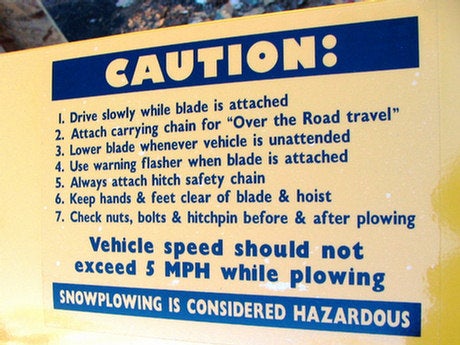 |
When the military asks for something on the other hand, things get done. That is why Arrowhead Engineering, Inc. makes a push-plate for the HMMWV that allows a full sized Fisher plow to be installed. A call into them revealed that for a civilian Hummer H1, one can expect an installation cost of in excess of $5,000.00 for one of these setups. Expect to lose quite a lot of approach angle when that plow frame is installed, too, which can be a real bummer if there are any wheeling plans in that trucks future. Meyer makes a snowplow kit that will work on Hummer/HMMWV vehicles as well. Each of the aforementioned plow setups are the real deal designed for commercial plowing applications. Those responsible for clearing private roads, multiple rental properties or parking lots may want to look into one of these heavier duty options; but for those of us planning to clear a long driveway or two, these might be overkill. And how about all those H3’s out there? Nobody wants to hang 800+ lbs of steel off the front end of one of those.
For the aspiring non-professional snow removers out there who don’t want to spend half a day shoveling or snow-blowing their long driveways every time the snow falls, there are a few consumer-grade “personal” snowplows on the market. The great thing about these plows is that they are designed to be used with relatively small, light vehicles, and all models of Hummer fit that bill very neatly. The bad thing about them is that the quality of construction and durability of these lighter duty plows vary greatly, and the down-pressure on these plows is minimal, which limits their ability to scrape the surface clean effectively. Also keep in mind that some Hummer models are quite wide, so some of these mini-plows wouldn’t even clear a path as wide as the track-width of the truck in one pass.
After weeks of investigating compatible options, inspecting products and a few days of deliberating, I finally plunged into the world of snow-plow ownership. One long phone call with Michael Biance from Driveway Superplow helped me finally make up my mind.
The Driveway Superplow is a rear mounted plow that installs in a standard 2” receiver hitch. I didn’t like the idea of having to drive over the snow before plowing it, but Mike assured me I would be very happy with the results, thanks to the two heavy springs that supply a healthy dose of down pressure on the plow. So, I decided to give it a shot.
A week after I sent in my check, a large wooden crate with wings appeared at the bottom of my driveway. When I was on the phone with Mike, he tried to talk me into driving to New York to pick up the plow. When I started to unpack the plow, I realized why. I don’t know how long it takes him to pack one of these things up, but I have seen houses that weren’t built as well as this crate. I would bet there were over 100 sheetrock screws holding together the wooden parts of that packaging. When I finally got all the packing materials cleared away, I stood back and looked at the 8’ rear plow. This thing is built like a tank. It features thick, heavy gauge steel everywhere, and clean massive welds that make the other lightweight consumer plows look like toys in comparison.
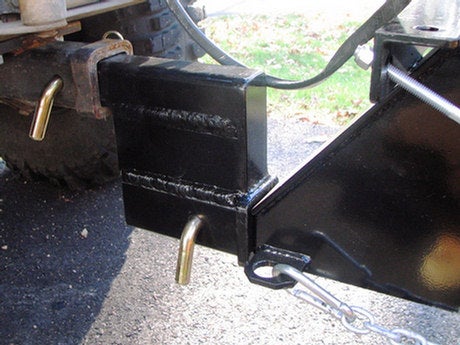 |
Installation of the plow is straightforward. Wiring, solenoid, and switch along with generic mounting instructions are included in the package. The solenoid appears to be a standard part for Meyer plows, so a replacement could be found locally with little difficulty. Mike was very helpful and responsive throughout the process of ordering and installing the plow, and he provided a properly sized drop-adapter to accommodate the unusually high hitch on my rig.
So, how well does this new plow work?
After waiting through all of November and December for some snow to test the plow on, it finally came- remarkably, December 30 th marked the first accumulation of snow in southern New Hampshire. I hooked up the plow and went to work on our driveway, which is about as difficult a test one could come up with. It is steep, curves in multiple directions, and pitches in multiple directions to drain off to each side, and features two swales.
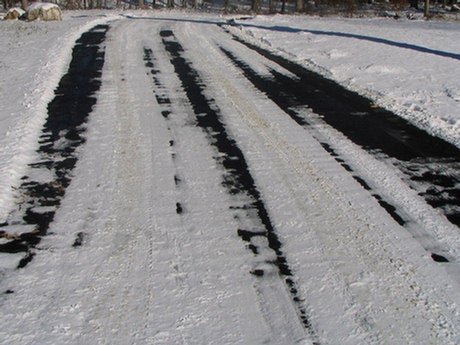 |
The First Pass |
The plow did an OK job on the initial passes, leaving some snow in its wake, and leaving the tire tracks where the truck had driven over the snow in front of the plow in place. Overall, it removed the bulk of the snow, but didn’t scrape clean as I had hoped. In fairness, the plow has adjustable springs, and I had them cranked down pretty tight for maximum down-pressure; it is possible that I need to experiment more with that tension before finding the ideal setting to scrape clean on the first pass.
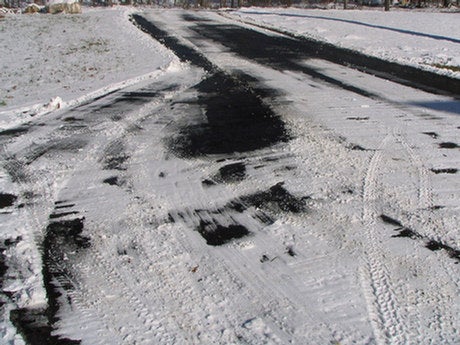 |
The Second Pass |
When pushing the snow to the side in reverse, the plow scraped the snow cleanly, exposing bare pavement. With a little practice I learned that by pulling the bulk of the snow forward, and then scraping and pushing what was left in reverse, I was able to do an admirable job of plowing the driveway. And this was all on my first day of using the plow.
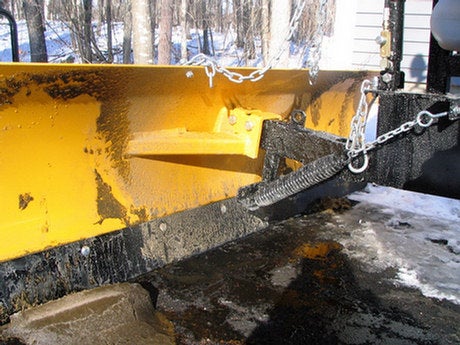
The controls were easy to use (Up, Down with the plow, forward, reverse and steer with the truck), and the automatic angling of the plow really took care of the rest. When I was done, I was able to position the caddy under the plow, disconnect it, and pull it off the truck with ease. Overall, it was a pretty good first experience with the plow.
I will update the results next month (presumably with a lot more days of plowing under my belt) before drawing any firm conclusions about the plow, but I am optimistic at this early stage. More to come on February 1 st!
|